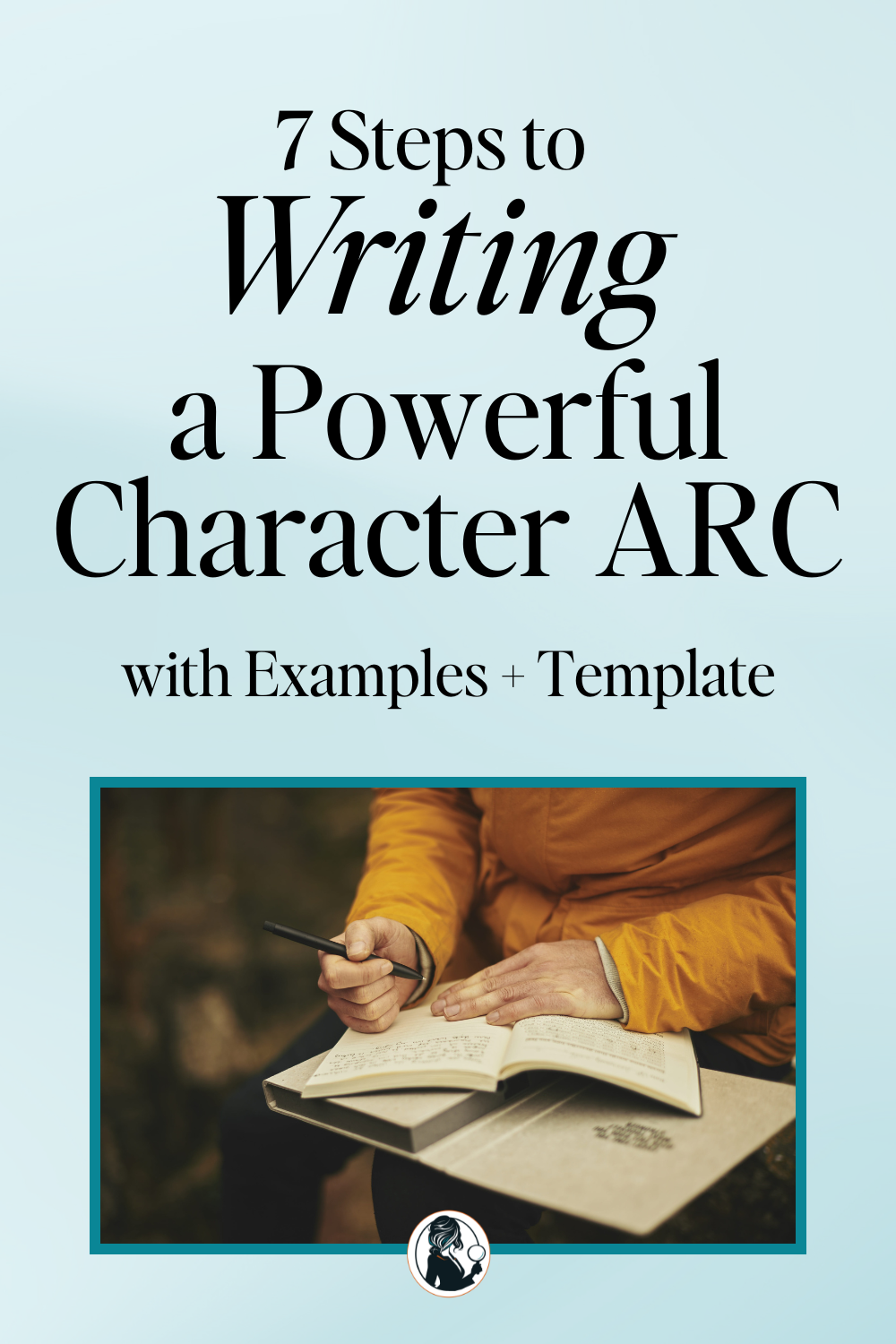7 Steps to Write a Powerful Character Arc (with Examples + Template)
At the heart of every unforgettable story lies a great character arc. It’s the transformation—or refusal to change—that makes a character feel real, their journey relatable, and their struggles universal. It’s the reason we remember characters long after the movie or series has ended.
What Is a Character Arc?
A character arc is the internal journey your character undergoes throughout the story. It’s not just about external events but how those events shape their beliefs, emotions, and decisions. Strong arcs don’t just show change—they explore why a character resists change, what triggers the transformation, and how their choices ripple into their relationships and impact their world.
Why Character Arcs Matter
Readers connect with stories when they see themselves in the characters. A great arc reflects just how messy life is (what’s more relatable than that?) It’s the struggle to grow, the pull of fear, the triumphs (or failures), and how we get back up that define us.
But here’s the nuance: not all arcs are about sweeping changes. You’ll find some great character examples below that show some characters grow incrementally, others descend into tragedy, and a few remain steadfast, influencing the world around them. The key is creating arcs that reflect the complexity of human nature while driving your story forward.
This guide will help you build layered, nuanced arcs for your characters. By exploring how characters change (or don’t) and when to apply the right character arc, you’ll craft richer stories that resonate deeply with your audience. Plus, at the end, you’ll find a step-by-step character arc template to guide your process.
The Types of Character Arcs
There are three types of character arcs at the highest level: Positive, Negative and Flat.
1. Positive Character Arc: Growth and Transformation
A positive character arc is all about growth. The character starts flawed or incomplete, believing a lie about themselves or the world that holds them back. Over the course of the story, they face challenges that force them to confront and ultimately overcome this false belief. By the end, they’ve grown stronger, wiser, or more whole.
Positive arcs inspire hope, showing that change and growth are possible even in the face of adversity.
Jimmy Hurdstrom in Yellowstone undergoes a remarkable journey —which makes him a great positive character arc example. At the start of the series, Jimmy is a troubled young man with no direction, struggling with addiction and self-worth. Taken under John Dutton’s wing, he learns discipline, hard work, and respect for himself and others. Over multiple seasons, Jimmy transforms from a lost soul into a confident and capable cowboy, earning his place and building a new life.
In fact, there’s even a YouTube video about the evolution of Jimmy:
Another example is Marlin from Finding Nemo. At the start of the movie, Marlin is an overprotective father who is terrified of the world beyond his reef. His journey to find his son, Nemo, forces him to face his fears, trust others, and ultimately allow Nemo to grow and take risks. By the end of the story, Marlin evolves into a more confident and open-minded parent, embodying the positive arc of transformation.
2. Negative Character Arc: Downfall
A negative character arc explores the darker side of transformation. Here, the character starts with flaws or unresolved fears, but instead of overcoming them, they succumb to their worst instincts. Their refusal to embrace the truth leads to their downfall, often with tragic consequences.
Negative arcs delve into the consequences of resisting growth or clinging to destructive beliefs, often serving as cautionary tales.
While I didn’t watch Breaking Bad, it was one of my husband’s favorite shows, and I’ve heard plenty about Walter White’s downward spiral — which makes this the perfect negative character arc example. He begins as a mild-mannered teacher who justifies his descent into crime as being “for his family.” Over time, his greed and pride transform him into a ruthless criminal, leading to his ultimate destruction.
This video below shows a moment that many say is the turning point in Walter’s arc toward bad:
3. Flat Arc: Steady but Influential
A flat character arc isn’t about internal transformation; it’s about a character whose unshakable beliefs inspire change in others or the world around them. These characters act as a stabilizing force, often challenging others to grow or reevaluate their own perspectives. They are stable themselves through the story and often remain unchanged through the course of a story.
Flat arcs highlight the power of consistency and conviction in a chaotic world.
A great flat character arc example is from one of the classic 80s movies for my Gen X generation, The Breakfast Club.
Brian Johnson, the “brain,” (played by Anthony Michael Hall) exemplifies a flat character arc through his unshakable belief in the importance of connection and understanding. From the start, Brian values academic success and approval but also craves emotional connection. Despite the group’s initial judgments and stereotypes, Brian’s vulnerability and honesty about his own struggles create a space where others feel safe enough to open up.
While the other characters undergo changes in how they view themselves and each other, Brian remains consistent in his belief that sharing emotions and finding common ground can bring people together. His role as the writer of their collective letter symbolizes his ability to unite the group, reflecting his steadfast belief in the power of communication and connection to break down barriers. By the end, Brian is still the academic achiever, but his values have inspired growth and introspection in the others, making him a catalyst for change without undergoing a transformation himself.
Don’t Forget the Antagonist’s Arc
While much focus is often placed on the protagonist’s journey, it’s crucial to consider the arc of your antagonist as well. The best villains are those who believe they are the heroes of their own stories. They have motivations, goals, and struggles that drive their actions, making them complex and compelling.
For example, Arvin Sloane in Alias is one of the most memorable antagonists because he truly believes in his mission. Sloane’s arc is rich with moments of doubt, moral conflict, and steadfast conviction, making him a multidimensional character. His belief in his righteousness often mirrors the protagonist’s own struggles, creating a dynamic and layered conflict.
Actionable Tip: When crafting your antagonist’s arc, ask:
- What lie do they believe?
- How does their journey intersect with or oppose the protagonist’s?
- What moments show their humanity, even in the face of their villainy?
Bonus tip: Contrast is one of the keys to a great character arc.
One of the most memorable workshops I attended was with Donald Maass. When he began his talk, he noted that in the first five minutes, the reader needs to see the contrast of your character. If he’s a regular Joe, you need to see him do something heroic— even if it’s small. If he’s a hero, you need to see a regular moment. That has stuck with me ever since.
By giving your characters a compelling arc, you create richer, more engaging stories where every character feels vital.
Building Deep, Relatable Character Arcs
So how do you build these arcs? How do we weave them into the plot and the story structure?
1. Start with the “Lie” Your Character Believes
Every character begins with a false belief about themselves or the world. This “lie” holds them back and drives their decisions. It’s not always a big lie, and it’s often a part of the worldview they’ve created to survive or move forward in lie.
A few examples of this:
- Chandler Bing in Friends — His lie is that using humor to deflect vulnerability will protect him from being hurt. He relies on sarcasm and jokes to avoid serious emotional conversations and shield himself from rejection. Eventually, he opens up to Monica and their relationship challenges and changes him to confront his fears, learn to open to intimacy. Chandler’s character arc over the course of the show is probably the biggest of all of the characters.
- Elle Woods in Legally Blonde — Her lie is that her worth is tied to her appearance and how others perceive her. She initially believes she needs to change herself to fit into her exboyfriend’s world.
In the book I’m working on now, my character’s lie is that she needs to be perfect and live a perfect life to be happy and accepted. It creates havoc in her world, because the only way to “appear” perfect is to be dishonest, to hide truths from herself and others.
Actionable Tip: Write down your character’s lie. Ask: How does this lie protect them from fear or pain?
What informs the lie they tell themselves? Build even more depth into your characters before diving into their arcs with this Easy Character Template for Writers to outline their traits, motivations, and relationships before you dive into the mess.
2. Define the Truth They Need to Learn
The truth is the lesson your character must confront to grow (positive arc), fail to embrace (negative arc), or embody from the start (flat arc).
For example, Buffy in Buffy the Vampire Slayer learns that her humanity and vulnerability make her stronger, not weaker.
Another example is Sandy in the movie Grease, who discovers that confidence doesn’t come from changing who you are but embracing your true self.
Actionable Tip: Pair the lie with its opposite truth. How will this truth challenge your character’s worldview?
3. Introduce a Catalyst That Disrupts Their World
The catalyst forces the character to confront their lie, often throwing their world into chaos.
For instance, in the movie Twister, Jo’s drive to chase storms stems from unresolved grief. The catalyst—a massive tornado outbreak where a loved one was in danger—forces her to face her fears and her belief.
Another example is in The Greatest Showman. P.T. Barnum’s ambition is catalyzed by his desire to rise above his humble beginnings and his need to prove something to his wife’s father (and himself).
Actionable Tip: Identify the event, person, or challenge that sparks your character’s journey.
4. Build Resistance Through Setbacks
Change is hard, and your character will resist it. This resistance creates tension and keeps arcs from feeling rushed.
For instance, Lorelai in Gilmore Girls resists reconciling with her parents, leading to conflict and incremental growth. Similarly, Elsa in Frozen initially resists embracing her powers out of fear, creating tension and emotional setbacks.
Going to back to the same workshop with Donald Maass, he often talks about not being too kind to your characters. If they have a pleasant life where nothing really happens, they don’t change. The challenge is to see what else can you take from your character? If they believe they have one friend, how can you challenge that belief? If they hide in their work to avoid change, take their job away in some way.
Actionable Tip: Plan 2-3 moments where your character clings to their lie or retreats from change.
5. Define Key Turning Points in their transformation
Turning points are pivotal events that force the character to reevaluate their beliefs. These may or may not line up with the turning points of your story structure. But the character arc needs to have its own.
In The Hunger Games, Katniss bonds with Rue which marks her shift from survivalist to protector. Another example is in Inside Out, where Joy’s realization that sadness is an integral part of Riley’s emotional growth becomes a turning point for both the character and the story.
Actionable Tip: Map out specific moments where your character makes decisions that reflect growth or failure. They can be big or small but they need to be meaningful.
6. Establish the Point of No Return
At this stage, your character realizes they can’t go back to who they were. They must fully embrace the truth or double down on the lie.
For instance, in The Devil Wears Prada, Andy’s decision to quit her job reflects her rejection of the lie. Similarly, in Frozen, Elsa’s choice to embrace her powers marks the moment she accepts her true self.
Actionable Tip: Identify when your character fully commits to their transformation.
7. End with Resonance
Whether the arc is positive, negative, or flat, the ending should feel earned and meaningful.
For example, in Gilmore Girls final Netflix show, Emily’s positive character arc is complete when she embraces the life she wants for herself, not the life she managed with Richard for decades. She does it in big fashion, moving to the beach, taking on a volunteer position with gusto and embracing the family that ends up living and working with her. Emily attempting to care for NAME at the end is about as opposite of where she started as you can get.
Actionable Tip: Tie the resolution back to the lie and truth. How has the journey changed your character?
Rory Gilmore’s Character Arc as an Example
To give you a full example of how this character arc can be written, let’s use Rory Gilmore from Gilmore Girls as a character example. I’m a huge Gilmore Girls fan and have dissected much of the show over the years.
Every time I watch this show, I gain different perspective on the characters. Emily’s arc was my favorite. But Rory is the perfect character to look at because her lie is constant throughout the show and she continually faces moments that force perspective — but whether she learns and grows is the question. Here’s a way to look at Rory’s Character Arc over the course of the seasons:
Starting State:
Rory Gilmore begins as an academically gifted and ambitious teenager raised by her independent mother, Lorelai. She is confident in her abilities, kind, and well-liked but focused on ensuring her meticulously planned life goes exactly as intended. Rory isn’t reliant on others’ opinions but deeply tied to the idea that sticking to her plan will lead to success and happiness. Her vision is clear: follow the path she and Lorelai have mapped out, and everything will fall into place.
- Core Strengths: Intelligent, empathetic, diligent, and optimistic.
- Flaws: Overly reliant on her plans, struggles with resilience, and avoids failure or confrontation.
The Lie:
Rory believes that perfection in following a meticulously crafted plan will ensure happiness and fulfillment. This belief creates a fragile foundation for her identity, as her sense of self-worth becomes tied to achieving her goals and maintaining control. It gives her very little room for failure or adapting to challenges or setbacks.
- How It Protects Her: This lie allows Rory to maintain a sense of control over her future. Consider the life she lived with her mother: just the two of them, struggling for money at times, sheltered in a small town, but there was this big, lofty goal in front of her. By adhering to a rigid plan, she avoids confronting the uncertainties and imperfections of life.
The Truth:
Rory needs to learn that happiness and fulfillment don’t come from perfection (which is unattainable) and that you can’t map your way to a perfect life, but building resilience, adaptability, and embracing imperfection help you continue the journey. Rory’s journey repeatedly challenges her to learn this truth, though her inability to fully accept it creates ongoing tension.
The Catalyst:
Rory faces several pivotal events that disrupt her sense of control and force her to confront her lie. There were smaller moments such as Paris telling Rory about all of the extracurriculars she needed to get into college. But there were a few larger moments too:
- Harvard vs. Yale: Growing up, Rory’s entire identity was tied to attending Harvard. Choosing Yale instead, influenced by Lorelai’s feelings and her own uncertainty, begins to unravel the notion that her life can follow a perfect, preplanned trajectory.
- How It Forces Confrontation: The decision reflects Rory’s realization that even her most carefully laid plans are subject to change. This choice introduces subtle cracks in her worldview, setting the stage for larger conflicts later.
- Mitchum Huntzberger’s Critique: Mitchum tells Rory she doesn’t have what it takes to be a journalist, shattering her belief that hard work and adherence to her plan guarantee success. His authority in the field makes this moment particularly devastating.
- How It Forces Confrontation: Mitchum’s critique undermines Rory’s carefully crafted self-image, leaving her unsure of her abilities and future. Without a clear plan forward, she spirals, quitting Yale and seeking refuge in her grandparents’ privileged world, delaying her reckoning with the truth.
- Logan moving to Palo Alto and proposing to Rory.
Resistance:
Rory’s resistance to change manifests in avoidance and overcorrection:
- Dropping Out of Yale: Mitchum’s critique prompts Rory to leave Yale, a drastic and impulsive decision that highlights her inability to face perceived failure. By retreating to her grandparents’ home, she avoids dealing with the deeper issues underlying her actions.
- Clinging to Privilege: Throughout her journey, Rory relies on her grandparents’ wealth and connections to regain a sense of stability and control, reinforcing her lie rather than addressing it. She immediately allows herself to follow in the planned footsteps because it’s easy and she knows what to do. The potential for failure is slim.
Turning Points:
- Returning to Yale: After months of living with her grandparents, Rory decides to return to Yale. This choice suggests growth, as she begins to reclaim her path, but it’s more about restoring her planned trajectory than confronting the root cause of her struggles.
- Pursuing the Reston Fellowship: Rory gives up a solid job offer to apply for the prestigious fellowship, but her approach is hesitant and unconfident, revealing lingering self-doubt from Mitchum’s critique. This moment highlights her ongoing tension between ambition and fear of failure. It also suggests she hasn’t totally learned from clinging to a planned approach. The job itself would have been uncomfortable and new, and Rory stuck to her preordained decisions.
Point of No Return:
When Rory is rejected from the Reston Fellowship, she faces a moment of truth. This rejection forces her to acknowledge that perfection and privilege cannot guarantee success. Though she moves forward, pursuing other opportunities, her reliance on controlling her narrative remains a challenge.
Climax:
Rory’s decision to say no to Logan and cover Obama’s campaign trail at the end of the series reflects both growth and incompletion. While she embraces an unexpected opportunity, it’s not the bold, Christiana Amanpour-style path she once dreamed of. This resolution may show that she’s learned to be more adaptable, but it leaves questions about her ability to fully let go of her lie.
Ending State:
Rory achieves professional success and maintains strong relationships with her family, but her arc remains unresolved in key ways. She sacrifices her relationship with Logan — presumably to “not have everything planned out for her.” But her reliance on privilege and perfectionism persists, and the job itself is more of a new planned path. In many ways, accepting Logan’s proposal or at least moving to start brand new in California would have been the unplanned path. It’s a debate for sure on whether she ever fully embraced imperfection and can weather storms with resilience.
What do you think of this character arc? There are many ways to look at a character and determine the story and journey they’ll go on. Understanding each of these areas for your characters will give you a much stronger journey.
Your Character Arc Template
Use this step-by-step template to map out your character’s journey:
- Starting State:
- Who is your character at the beginning?
- What are their core strengths and flaws?
- The Lie:
- What false belief holds them back?
- How does this lie protect them?
- The Truth:
- What truth must they confront?
- How does this truth challenge their worldview?
- The Catalyst:
- What event disrupts their world?
- How does this force them to confront their lie?
- Resistance:
- How does your character resist change?
- What flawed decisions do they make?
- Turning Points:
- What key moments force them to reevaluate their beliefs?
- How do these moments bring growth or failure?
- Point of No Return:
- When does your character realize they can’t go back?
- What fear or desire pushes them forward?
- Climax:
- What defining decision reflects their growth or failure?
- How does this resolve the central conflict?
- Ending State:
- Who are they at the end of the story?
- How have their relationships or worldview changed?
- Ripple Effect:
- How does their transformation impact others or the world?
- What lasting change does their journey create?
Conclusion: Writing Arcs That Reflect Us All
Great character arcs don’t just entertain—they reveal truths about ourselves.
As you craft your characters, draw from your own experiences and emotions. Let their struggles mirror your own, and their transformations inspire your readers. Whether your arc is a tale of redemption, tragedy, or steadfast influence, remember this: the journey matters as much as the destination.
If you’re ready to take your character development to the next level, check out my Work in Progress Notebook for a practical and creative way to organize and refine every aspect of your story.
Now it’s your turn. Start mapping your character’s arc and watch your story come to life.




